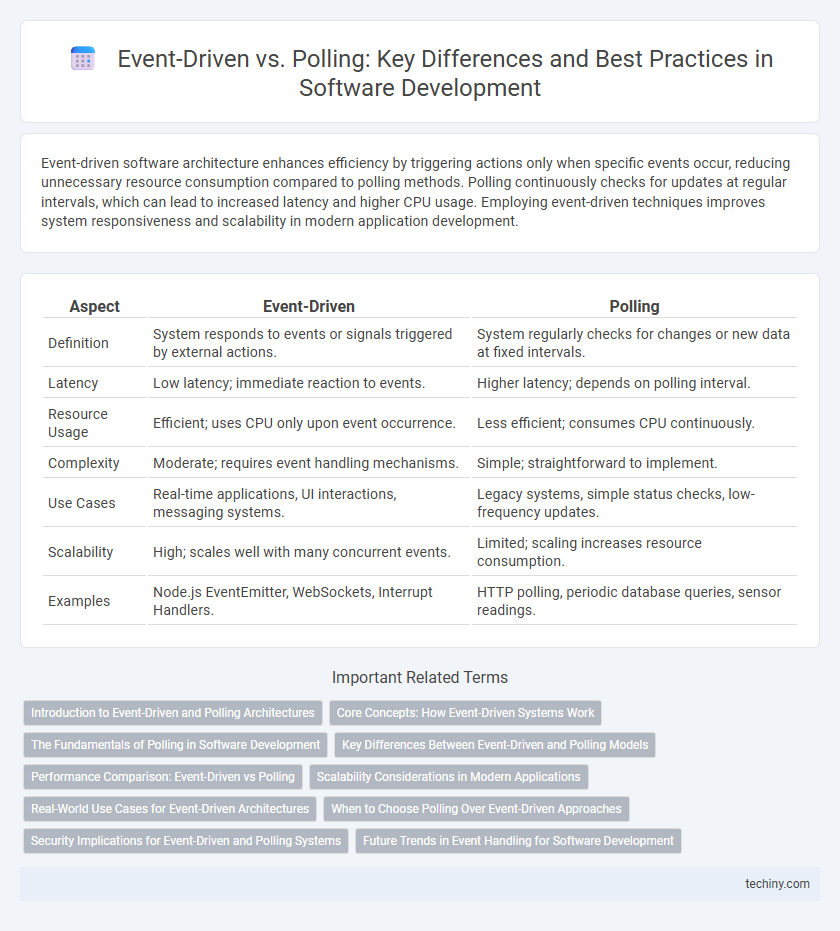Event-driven software architecture enhances efficiency by triggering actions only when specific events occur, reducing unnecessary resource consumption compared to polling methods. Polling continuously checks for updates at regular intervals, which can lead to increased latency and higher CPU usage. Employing event-driven techniques improves system responsiveness and scalability in modern application development.
Table of Comparison
| Aspect | Event-Driven | Polling |
|---|---|---|
| Definition | System responds to events or signals triggered by external actions. | System regularly checks for changes or new data at fixed intervals. |
| Latency | Low latency; immediate reaction to events. | Higher latency; depends on polling interval. |
| Resource Usage | Efficient; uses CPU only upon event occurrence. | Less efficient; consumes CPU continuously. |
| Complexity | Moderate; requires event handling mechanisms. | Simple; straightforward to implement. |
| Use Cases | Real-time applications, UI interactions, messaging systems. | Legacy systems, simple status checks, low-frequency updates. |
| Scalability | High; scales well with many concurrent events. | Limited; scaling increases resource consumption. |
| Examples | Node.js EventEmitter, WebSockets, Interrupt Handlers. | HTTP polling, periodic database queries, sensor readings. |
Introduction to Event-Driven and Polling Architectures
Event-driven architectures rely on asynchronous event notifications to trigger system processes, enhancing efficiency by executing actions only when specific events occur. Polling architectures continuously check for changes or updates at regular intervals, which can lead to unnecessary resource consumption and increased latency. Understanding these foundational approaches enables developers to design systems that balance responsiveness and resource management effectively.
Core Concepts: How Event-Driven Systems Work
Event-driven systems operate by listening for and reacting to specific events or messages, enabling real-time responsiveness and efficient resource utilization. These systems use event handlers or callbacks triggered automatically when an event occurs, avoiding constant resource consumption typical in polling methods. This approach enhances scalability and performance by processing events asynchronously and decoupling event producers from consumers.
The Fundamentals of Polling in Software Development
Polling in software development involves repeatedly checking the status of a resource or event at regular intervals to detect changes or updates. This method consumes more CPU resources compared to event-driven approaches because it continually queries the system regardless of state changes. Despite its inefficiency, polling is simpler to implement and can be suitable for environments where event signaling is not available or reliable.
Key Differences Between Event-Driven and Polling Models
Event-driven models rely on asynchronous notifications to trigger actions only when specific events occur, optimizing resource usage by preventing constant system checks. Polling models continuously query the system at regular intervals, potentially causing higher latency and greater CPU consumption due to repetitive status checks. Event-driven architectures enhance system responsiveness and scalability, whereas polling can simplify implementation at the cost of efficiency and real-time performance.
Performance Comparison: Event-Driven vs Polling
Event-driven architecture significantly outperforms polling by reducing CPU usage and network overhead, as it processes events only when they occur rather than continuously checking for changes. Polling frequently leads to wasted resources and increased latency due to repetitive status checks, especially in high-frequency or large-scale systems. By leveraging asynchronous event notifications, event-driven systems provide faster response times and higher scalability in complex software applications.
Scalability Considerations in Modern Applications
Event-driven architecture enhances scalability in modern applications by efficiently handling large volumes of concurrent events without constant resource consumption. Polling mechanisms, while simpler, often lead to increased latency and higher resource usage due to continuous checking for updates, limiting scalability under heavy loads. Choosing event-driven systems with message brokers like Apache Kafka or RabbitMQ optimizes throughput and reduces system overhead, crucial for distributed and cloud-native environments.
Real-World Use Cases for Event-Driven Architectures
Event-driven architectures excel in real-world applications such as financial trading platforms, where real-time data processing and instant reaction to market changes are critical. IoT systems use event-driven models to handle asynchronous sensor data, enabling prompt responses to environmental changes without continuous resource consumption. Similarly, e-commerce platforms benefit from event-driven systems by efficiently processing user actions like cart updates and payment transactions, ensuring scalable and responsive user experiences.
When to Choose Polling Over Event-Driven Approaches
Polling is preferable when system resources allow frequent checks without significant performance degradation, especially in environments with simple or legacy hardware lacking event notification capabilities. It ensures continuous data acquisition when event-driven interrupts are unavailable or unreliable, providing predictable timing and easier debugging due to its straightforward control flow. Polling suits scenarios with low event frequency or infrequent changes, avoiding the complexity and overhead of implementing event listeners or handlers.
Security Implications for Event-Driven and Polling Systems
Event-driven systems enhance security by minimizing exposure to unauthorized data access through real-time event notifications, reducing the risk of continuous data polling vulnerabilities. Polling systems often increase attack surfaces due to frequent requests, making them susceptible to denial-of-service attacks and data interception. Implementing secure authentication and encryption protocols is crucial in both architectures to protect event integrity and prevent unauthorized access.
Future Trends in Event Handling for Software Development
Event-driven architectures are increasingly preferred in software development due to their efficiency and scalability in handling asynchronous operations, reducing system latency compared to traditional polling methods. Emerging trends emphasize the integration of AI-powered event processing to enable predictive analytics and real-time decision-making, enhancing responsiveness in complex applications. The adoption of serverless computing and edge computing further accelerates event-driven frameworks by minimizing resource usage and improving performance in distributed environments.
Event-Driven vs Polling Infographic

 techiny.com
techiny.com